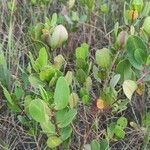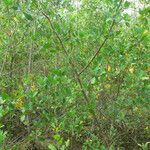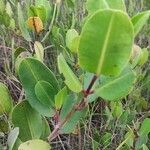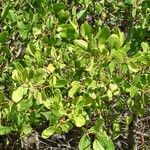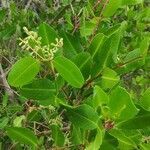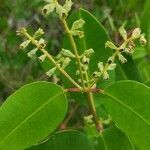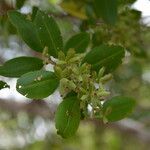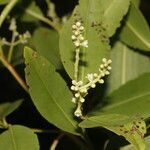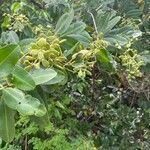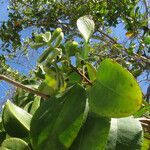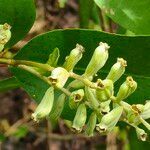Small tree up to about 10 m. high or bush, with glabrous branchlets usually chestnut-brown when dried, slightly swollen at the nodes. Leaves opposite, decus-sate, petiolate, petiole 1-1.5 cm. long, glabrous, with two conspicuous glands 2-4 mm. below the apex, lamina chartaceous to subcoriaceous, elliptic or oblong-elliptic, up to 10 X 5.5 cm., glabrous, usually blunt or rounded at the apex and slightly rounded at the base, lateral nerves rather numerous but inconspicuous, reticulation just visible. Flowers white or greenish-white, sessile, 5-merous, in terminal panicles up to about 20 cm. long of elongated spikes up to 7-8 cm. long, rhachis densely appressed-pubescent, bracts suborbicular to ovate, pubescent, 1.5 X 1.3 mm., soon caducous. Receptacle infundibuliform, elongating as the fruit develops, tomentel-lous, 2.5 X 1.5 mm., with two small obversely elliptic bracteoles, 1.5 X 2 mm., near the apex, expanded at the apex into a persistent cupuliform calyx with 5 broad lobes, imbricate in bud. Petals 5, suborbicular, appressed-pubescent. Stamens 10, filaments very short, inflexed in bud, inserted near the margin of the disk. Disk fleshy, 10-rayed. Style 1 mm. long, glabrous, stigma capitate. Fruit flattened-obovoid-ellipsoid, at first densely later sparsely appressed-pubescent, 12-20 X 6-10 mm. when mature, more or less longitudinally winged or ribbed, wing up to 2 mm. broad but usually less than 1 mm., crowned by the persistent remains of the calyx.
A mangrove shrub or small tree. It grows 6 m high. The trunk is straight. The bark is grey with fine cracks along it. The roots extend away from the base of the trunk. There are breathing roots. The leaves are opposite and rounded at both ends. The leaves are smooth with faint side veins. There are 2 small glands on the leaf stalk. The flowers are white in spikes between the leaves. The fruit are winged capsules.
